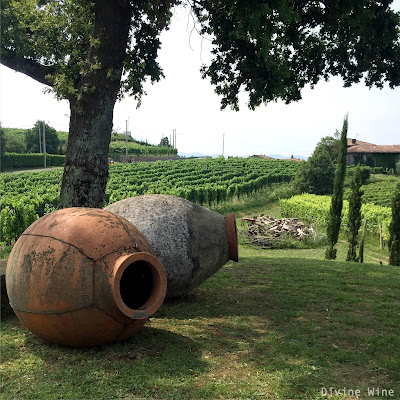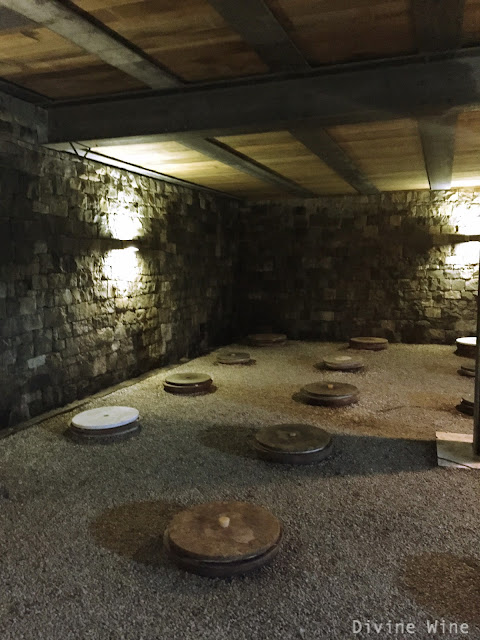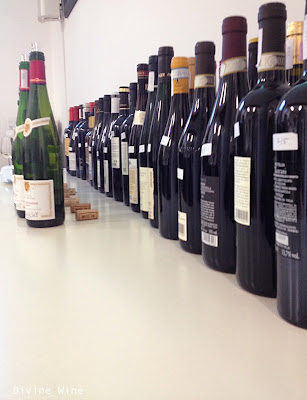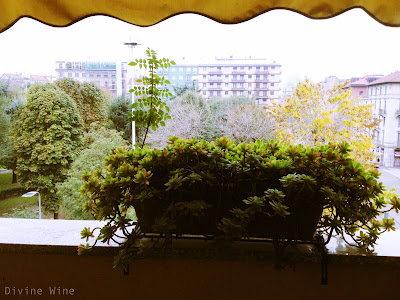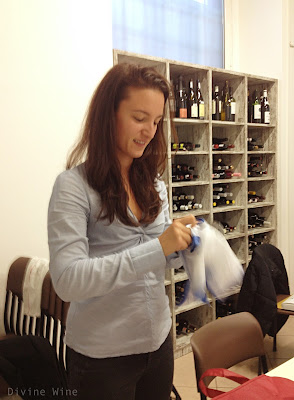Amber, not
orange
Standing
here, at the front yard of Gravner winery, in the village of Oslavia, I’ve
arrived at the heart of modern orange wine. Gravner’s main building is in
Italy, but so close to the Slovenian border that we can see over to the other
side: “those trees over there are in Slovenia!” This border region of Italy’s
Collio and Slovenia’s Brda is culturally very united. The border has been moved
around, and the separation between Collio and Brda (on the Slovenian side) is
practically artificial, hence the locals call it Collio-Brda. Also, this building is the only building in
the village of Oslavia that survived the First World War intact – at the time
it served as a hospital for the wounded. Today, its peaceful cellar protects
numerous gigantic, hand-made clay vessels called amphoras (or kvevris in
Georgian) that have been imported from Georgia. They are now buried in the
ground, where in their wombs they mature some of world’s most spectacular wines
made using prolonged skin contact. I had the privilege to spend an afternoon
with Mateja Gravner contemplating the delicate relationship between vineyard
care and nature’s balance, discussing Gravner’s ecologically responsible and
aware wine philosophy, and tasting their divine wines.
At the
vineyard
Mateja
takes us to their oldest vineyard planted with 7 hectares of white Ribolla
(this variety has a thousand year history in this area) and 1,5 hectares of red
and unpredictably grape yielding Pignolo (a local variety as well that almost
faced extinction, but made it back). And that is it. Gravner has stopped
growing international varieties. Although this vineyard hosts only two
varieties of grapes, many other plants and species abound. Promoting
biodiversity and protecting the surrounding ecosystem from human impact caused
by agriculture are of primary concern for Gravner. As planting the vineyard
causes the vines to be overrepresented in that particular system, Gravners have
decided to plant fruit, olive and other trees in the vineyard, and even build
artificial ponds to support the birds and insects. In this area, there has been
a loss of bird species in the past decades. However, thanks to ecologically
more aware agriculture and these kinds of interventions, the bird populations
have started to flourish again. Wine is nature’s product, and Gravner
approaches it as a part of the ecosystem. The more ecologically balanced the
vineyards are, the more balanced the grapes, and finally, the resulting wine.
And along the same lines, the less the wine is disturbed at any point of its
production, the more the final product reflects the grapes of origin. All this
crystallizes to outstanding quality in the glass.
Although
Gravner works with practically biodynamic (and organic) production methods,
they haven’t applied for any certifications. Why? Because they want to work
only according to the principles they themselves believe are most fruitful for
reaching best quality, on the contrary to working according to certificate
requirements that would at some instances require compromising from their own
standards. The accumulation of copper and sulphur compounds in the soil is
currently a common problem in organic vineyards because they are sprayed with
these repetitively to prevent fungal disease. Gravner has found a solution in
propolis and algae. With the help of these natural fungicides they have been
able to reduce the usage of copper and sulphur up to 40%. “Everything that
helps lessen the human impact on the soil must be at least tried”, says Mateja.
“How we
produce is how we live”
Listening
to Mateja, I begin to understand that for Gravner wine is a living organism
that develops and grows at its own pace. It needs to be listened to, its
process needs to be followed, not pushed. Mateja often compares wine with
growing children: like a child, wine
slowly becomes itself, with proper guidance and plenty of time. At Gravner this
time is approximately seven years – this is the time a wine needs to mature
after prolonged skin contact, and this is the time a child needs to grow before
she is ready for school. And like a proper parent, Gravner makes uncompromising
choices to reach a wine that reflects the true character of the original
grapes: only the healthiest and optimally ripe grapes are picked, the rest are
discarded. And only Georgian, hand-made clay vessels will do. Nothing less, no
matter how much effort it may require to get the cellar filled with them.
Before the
amphoras, Gravner produced their wines in a manner still very typical to
Collio: international varieties filled the vineyards and the cellar was full of
stainless steel and modern technology. No doubt, this set produced wines of the
highest quality with crisp acidity and fruity freshness – wines with international
appeal. However, Josko Gravner didn’t taste the original varietal taste of the
grapes in the end product. Further, he noticed that international wines as well
as the wines of his own area seemed to lose personality and approach a uniform
style. This bothered him.
A turning
point was reached in 1996. This was a very poor vintage. Gravner lost a devastating
92% of Ribolla grapes. Josko decided to experiment with the remaining 8% to
finally determine what interventions would allow or hinder the Ribolla varietal
taste of the fresh grapes to shine through in the wine. He attempted e.g.
making Ribolla wine with or without cultured yeasts; with or without prolonged
skin contact; with or without sulphites. The final results? Unsurprisingly,
Ribolla’s character was the clearest with minimal interventions. As a
conclusion, Josko Gravner opted for amphoras as they, without any other
technology but a minimal amount of sulphites, allowed for prolonged skin
contact and retained the fresh aromas of the wine. Mateja says: “Amphoras are nothing exotic –
they just bring together everything that is required to achieve a high quality
wine through extended skin contact without any extra technology.” (An article
about Kvevri/Amphora as a wine making technology is available here.)
 |
| Gravner's cellar is full of amphoras buried in the ground. |
Determined
to produce characterful wines, in 1997 Josko Gravner sold his shiny stainless
steel tanks and started his challenging journey towards creating a cellar full
of Georgian amphoras. Easier said than done. At the time Georgia was still
politically unstable. To travel there was a questionable undertaking as such,
but to get the actual amphoras to end up in Collio, a herculean task. The first
batch of amphoras arrived in no earlier than year 2000. There were eleven
amphoras, out of which nine were broken. Naturally, the conclusion was to order
more Georgian amphoras! The vintage of 2001 was the first when Gravner produced
some wine made in amphoras. Today, all their wine is produced in amphoras,
including the red Pignolo. After pressing, Pignolo moves into oak barrels to
mature, but Ribolla stays in skin contact for six months in amphoras before
racking, and after continues to mature in amphoras until the following autumn. After
this period also Ribolla is matured in large Slavonian oak vessels for six
years.
Tasting
wines together with Mateja Gravner crystallized the spirit of this uncompromising
winemaking philosophy into concrete reality. These wines were outstanding
throughout. Each of them would deserve a detailed, in-depth review. Attempting
to write a short version would not do them justice. Instead, I will warmly
recommend these wines for wine enthusiasts and anyone fascinated by unique
wines of outstanding quality. What I took home from this visit (alongside with
a couple of lovely bottles to my collection) was the comprehension that a wine
is born, when its process is allowed to take place in the right conditions
without extra manipulation. My visit at Gravner helped me to trust the process
instead of pushing the river – and this applies equally well to life as well as
wine making in kvevris/amphoras.
 |
| Amber wine. |
Coordinates
Azienda Agricola Gravner Francesco
Localita Lenzuolo Bianco 9
Oslavia 34170 Gorizia
tel. 0481 30882
info@gravner.it
gravner.it
Azienda Agricola Gravner Francesco
Localita Lenzuolo Bianco 9
Oslavia 34170 Gorizia
tel. 0481 30882
info@gravner.it
gravner.it
***
Dear
friends of wine and Divine Wine. This last article has taken me an unpardonably
long time to write. Another project outside wine has become very time intensive
in my life. So, dear friends, it is time to say good-bye, and thank you all for
reading Divine Wine blog. I wish you all the best wines now and in the future!
Cin cin!



